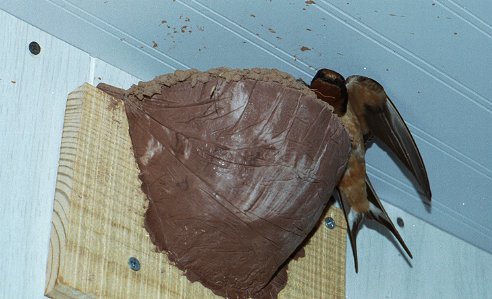Richard and Diane Van Vleck Personal Pages The Home Habitat |

Richard and Diane Van Vleck Personal Pages The Home Habitat |

Check the 2004 trial study of the weather cam and quad processor at the bottom of this page
The following still photos are taken from a single frame of video from the 6 hr vhs tapes. This process results in a substantial loss of quality compared to the original camera image and vhs tape.
ARTIFICIAL NEST "R"
ARTIFICIAL NEST "L"
ARTIFICIAL NEST "O"
ARTIFICIAL NEST "S"
2004 Barn Swallow Feeding Study
Barn swallows, being aerial insectivores, have difficulty catching enough insects to feed their young during bad weather. The effect of prolonged severe weather is demonstrated by nesting failures. But, frequent brief bouts of cold wet weather may also have an effect on nestling growth and fledging success. Monitoring the number of feeding visits at up to three same age nests as well as current weather conditions can be done by using a quad processor and vcr. I review the tapes in fast forward, sometimes watching only one nest at a time, since some feeding visits are of such short duration that they may be missed if trying to monitor all three quadrants of the screen simultaneously. Another option is to review the tape in realtime and watch all 3 nests at once, pausing the tape whenever necessary to enter data. Old fashioned hand counters are useful for tallying feeding visits without taking your eyes off the screen. Blood cell counters allow entering separate totals for each nest.
quad view - feeding visit at lower left.
quad cam - feeding visit at upper right.
| barn owl | American kestrel | purple martin | barn swallow | Eastern bluebird |
| tufted titmouse | Eastern phoebe | yellow shafted flicker | tree swallow | chimney swift |
| house wren | big brown bat | Carolina wren | brown thrasher | catbird |
| cedar waxwing | Northern mockingbird | |||
| Yellow warbler | Acadian flycatcher | |||
email richard@americanartifacts.com
© 2001 - 2013, American Artifacts and Richard Van Vleck, Taneytown, Maryland.